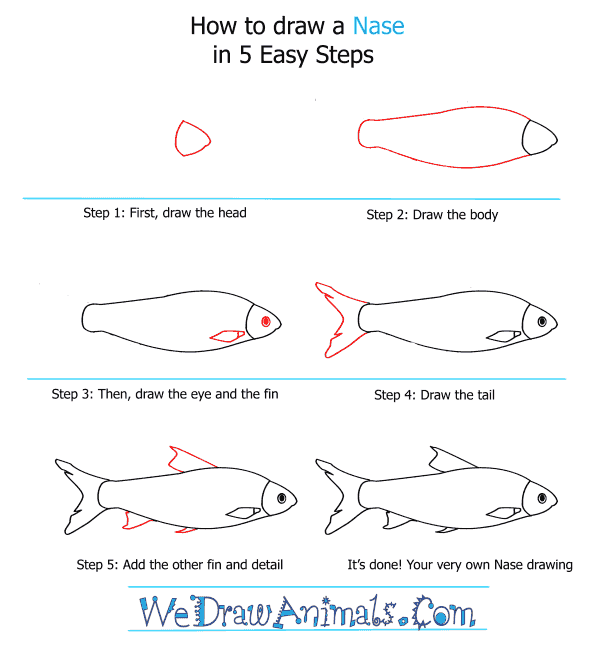In this quick tutorial you'll learn how to draw a Nase in 5 easy steps - great for kids and novice artists.
The images above represent how your finished drawing is going to look and the steps involved.
Below are the individual steps - you can click on each one for a High Resolution printable PDF version.
At the bottom you can read some interesting facts about the Nase.
Make sure you also check out any of the hundreds of drawing tutorials grouped by category.
How to Draw a Nase - Step-by-Step Tutorial
Step 1: Begin by drawing the head of the fish with a triangular shape with rounded corners
Step 2: Next, draw the body with two curved lines coming from the head. Draw a vertical line to connect them at the tail
Step 3: Draw the little fin and the eye. The fin is like an elongated diamond. Draw a circle with another filled in circle inside of it to create the eye
Step 4: Draw the tail with a few cuts for texture. The tail has two parts
Step 5: Draw three more fins on the top and bottom of the body. Each fin has a different shape and size, so follow the image exactly
Interesting Facts about the Nase Fish
The northern Nase is a medium-sized fish from the Cyprinidea family which is a group of fish with over 2,000 species. These fish are able to protrude their upper jaw while the lower jaw is slightly arched.The Nase is found from Spain to Portugal and have small scales. They have numerous black spots on the upper parts of their body. Their body is more elongated than other cyprinids with large dorsal and anal fins.
Did you know?
- Males get small tubercules over the body during breeding season where other species don’t have any differences between male and female.
- They like to live in freshwater rivers with strong currents and found swimming close to the bottom.
- They are a vulnerable species close to being endangered.
- Nase can be found in groups especially near migration and spawning time.
- They are toothless but have bones in the mouth to grind food to help in eating.
Canals and dams have been constructed with plans to construct more are greatly affecting the Nase habitat leading to destruction of their habitat. There is also a lot of agricultural and industrial waste being dumped into the water threatening the nase.






